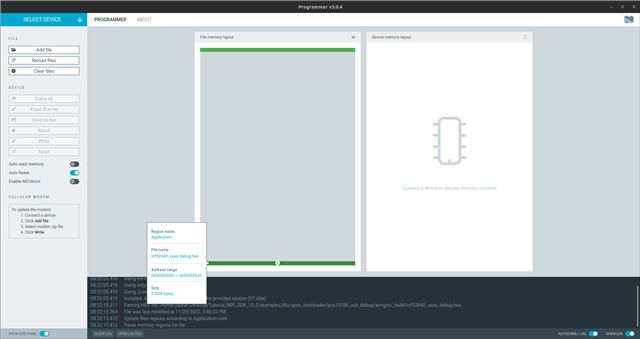Hello all,
Currently using an nRF52840-DK, GCC Makefile build tools including nrfjprog and nrfutil, Nordic SDK v15.0, SoftDevice s140 v6.0.0
I am currently trying to get a grasp on how the MBR, SoftDevice, DFU Bootloader, and Application all work together and I'm having a hard time combining some of the examples together cohesively. What I have done so far is the following:
- Installed the SoftDevice (which includes the MBR)
- Set the following debugging sdk_config.h elements for the bootloader example
- NRF_LOG_BACKEND_UART_ENABLED to 1
- NRF_LOG_ENABLED to 1
-
NRF_LOG_DEFERRED to 1
-
NRF_LOG_DEFAULT_LEVEL
- Installed a slightly customized open_bootloader (pca10056_usb_debug) example (I've simply added a few extra debug messages)
- Installed the ble_app_blinky example application
- Installed bootloader_settings generated using the nrfutil program
I am having an issue where the device gets stuck somewhere in the bootloader process. Based on some DEBUG messages that I've placed, it appears that it is having an issue in the nrf_dfu_mbr_irq_forward_address_set() function, called by the nrf_bootloader_app_start(). I am unable to get any DEBUG messages come out of the nrf_dfu_mbr_irq_forward_address_set() function, but right before this function is called is where I continue to get my last DEBUG message. The device gets here whenever it turns on from a power off/reset, and I want it to get past here and go to the blinky application which it cannot.
On the DK, I've got it set to where holding down Button 4 and turning the device on brings the device into DFU mode, where it gets stuck in the loop_forever() function found in nrf_bootloader.c and then I am unable to get to the application from here as well. Setting the NRF_BL_DFU_INACTIVITY_TIMEOUT_MS to 10000 will eventually cause it to exit loop_forever() and revert to the previously mentioned case, but again, not getting me to the application.
So I have two scenarios in which I am trying to get to the application from the bootloader:
- Whenever I turn the device on/restart via reset pin it gets stuck in the nrf_bootloader_app_start(), most likely the nrf_dfu_mbr_irq_forward_address_set() function.
- Whenever the device enters the DFU, I get stuck in the loop_forever() function and can't get to the application.
This is becoming a pretty big headache, so I appreciate any and all advice on the matter.


